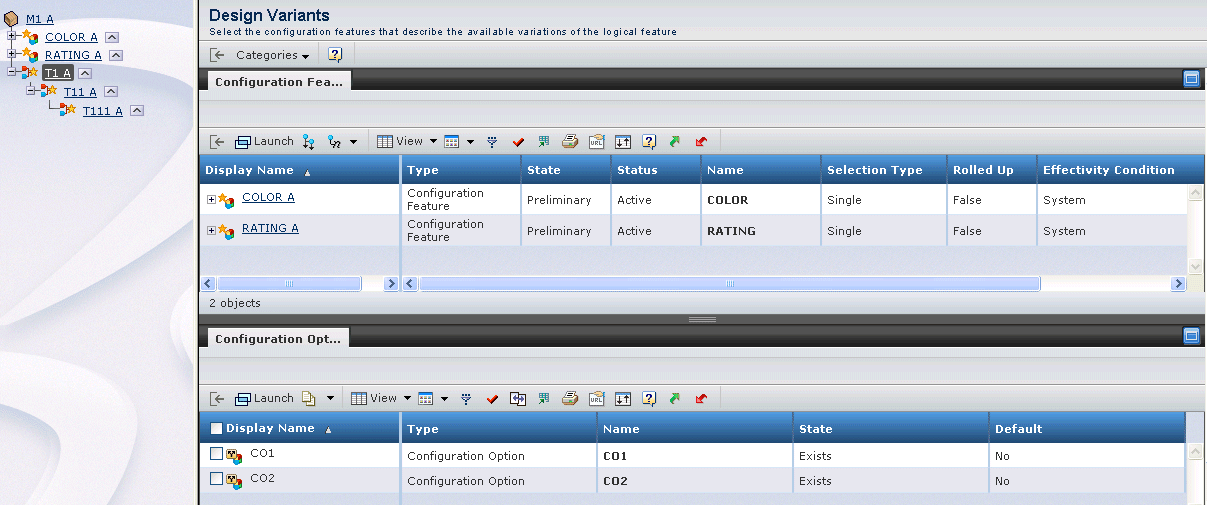To view the Design Variants page for a logical feature, do one of the following:
- From the Categories menu, select Logical Structures. In the Logical View tab, select a logical feature, then from the Reports menu, select View Design Variant.
- From the Categories menu, select Logical Structures. In the Logical View tab, right-click the highlighted name of a logical feature, then from the popup menu, select View Design Variant.
- Access the Properties page for a logical feature, then from the Categories menu select Design Variants.
The Design Variants page is displayed.

The Configuration Features table contains the following columns:
| Column |
Description |
|---|
| Display Name |
The display name of the configuration feature |
| Type |
Configuration Feature |
| State |
The current state of the configuration feature in
its lifecycle |
| Status |
Active or Inactive. Specifies
the availability of the feature for a product configuration. Inactive
logical features cannot be used in rules for parts. |
| Name |
The name of the configuration feature |
| Selection Type |
The selection option
of the feature, such as "May select only one," "Must select one or more,"
etc. |
| Rolled Up |
True or False. If a configuration
feature has been rolled up, it means it was inherited upward after being
added to a logical feature. When you add a configuration feature (or design
variant) to a logical feature, it is inherited upward by the immediate
parent logical feature. For example, if the Color design variant is
added to the Adapter logical feature, Color is inherited upward by
the immediate parent logical feature, which is Power Cord. |
| Effectivity Condition |
System or User-Defined.
- System (the default) means the active or inactive
status of the design variant has been set by the system through inheritance.
Setting the status manually changes the design variant's effectivity
condition to User-Defined and overrides any status set through inheritance.
- User-Defined means the active or inactive status of the design variant
has been set manually. Once a design variant's effectivity condition becomes User-Defined, it cannot be changed through future inheritance.
Note:
In a logical structure with multiple levels of logical features, if the effectivity condition on a parent logical feature is User-Defined, and if the same design variant is removed from a child logical feature, the design variant on the parent is not removed. The only way a User-Defined design variant can be removed is by using the Remove Design Variant command on the parent logical feature. However, the Remove Design Variant action cannot be performed on the parent logical feature if it has references in child logical features.
|
| Default |
The default value selected for the
configuration feature |
Use any of the following commands on the page Actions menu to work with the Configuration Features table:
- Add Existing Design Variant. Adds an existing
design variant to the list. The Search page opens.
- Make Active/ Make Inactive. Makes checked
features from the list inactive. The value toggles to Active to permit
you to return the feature to active. Inactive features are available
for product configurations. Inactive logical features cannot be used
in rules for parts. In the context of a product variant, you can make
a feature valid or invalid. The valid or invalid status of a feature
functions the same as active or inactive status.
- View Common Group List. You can view and edit
the list of common groups and their subfeatures for a selected feature.
- Remove Design Variant. Removes checked features
and subfeatures from a lowest level logical feature. This removes the
relationship between all checked items and the feature. It does not delete
the items from the database.
|